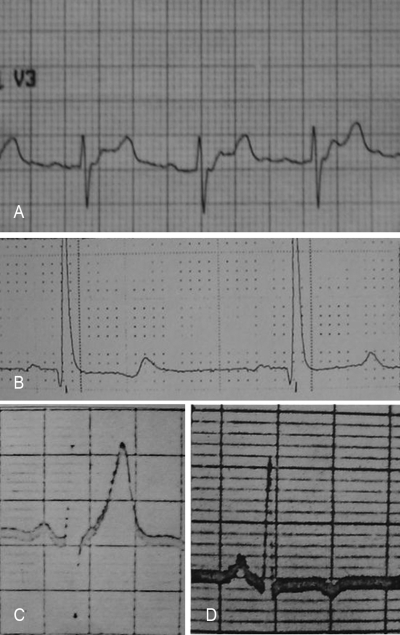To the Editor:
It is unfortunate that the electrocardiogram (ECG) revealing a ‘non-specific T wave abnormality’ was not recorded in the paper by Mahmoud and colleagues. It is unfortunate because these observers’ research has found the ECG invaluable in the differential causations of not only congestive heart failure per se, but also of dilated (congestive) cardiomyopathy. In chronic alcoholism, if a cirrhotic pathology coexists with heart muscle disease, the resultant hypomagnesemia, in itself encouraging hypokalemia, predisposes the patient to T wave alterations on ECG (1). When depleted, the metalloenzyme magnesium – the energy source for the sodium-potassium pump – produces T wave changes due to impairment of sodium-potassium-ATPase, resulting in a loss of intracellular potassium. The changes are accentuated by additive hypocalcemia if pancreatic exocrine dysfunction is concomitant.
Four specific repolarization mutations are worthy of description. First, Figure 1A illustrates the low-amplitude (‘molehill’) T wave of magnesium deficiency, in conjunction with the prolonged ST segment peculiar to hypocalcemia. Second, a diminutive low-voltage negative (‘dimple’) T wave is graphed when hypokalemia is predominantly operative (Figure 1B). Third, when the hypokalemic U wave exceeds the amplitude of the T wave (double-humped or axed) and the QRS complex widens diffusely, the resultant configuration is aptly termed ‘cloven’ (Figure 1C). Finally, what these authors have termed the somewhat bizarre ‘antler’ T wave (Figure 1D). Here, tall, narrow hypokalemic U waves coalesce with the peaked T waves of early magnesium deficiency to resemble the horn of a young deer.
Figure 1.
A ‘Molehill’ T wave. B ‘Dimple’ T wave. C ‘Cloven’ T wave. D ‘Antler’ T wave
In summary, given that magnesium and potassium deficits are fairly common in ethanol abuse, the specific ECG expressions of the same are valuable signposts that lead to the diagnosis, and ultimately therapeutics, of alcoholic heart muscle disease.
REFERENCE
- 1.Seelig MS. Electrographic patterns of magnesium depletion appearing in alcoholic heart disease. Ann NY Acad Sci. 1969;162:906–17. doi: 10.1111/j.1749-6632.1969.tb13020.x. [DOI] [PubMed] [Google Scholar]



